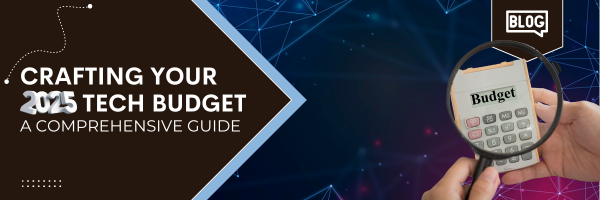As we boldly walk into 2025, the importance of a well-structured technology budget cannot be overstated. With advancements in AI, cybersecurity, and cloud infrastructure happening on the daily, businesses must strategically allocate resources to stay competitive and innovative.
Here’s a 7-step guide to help you create an effective technology budget for 2025.
1. Assess Current Technology and Needs
Start by evaluating your existing technology infrastructure. What do you have? How old is it? What are your technology pain points with your current setup? Conduct a thorough inventory of your hardware, software, and services. Identify what’s working well, what needs upgrading, and what can be phased out. This assessment will provide a clear picture of your current capabilities and highlight areas that require investment.
2. Define Technology Goals and Objectives
Align your technology investments with your business goals. Whether you aim to enhance customer experience, improve operational efficiency, or expand market reach, setting clear objectives will ensure your budget supports your strategic priorities. Establishing measurable goals also helps in tracking the success of your investments.
3. Allocate Budget for Key Areas
Divide your budget into key categories such as:
- Hardware and Software: Plan for upgrades, replacements, and new acquisitions.
- Personnel Costs: Include salaries, benefits, and training for IT staff.
- Maintenance and Support: Allocate funds for regular maintenance, licenses, and unexpected repairs.
- Security: Invest in robust cybersecurity measures to protect your data and systems.
4. Incorporate Emerging Technologies
Stay ahead of the curve by investing in emerging technologies. In 2025, AI and generative AI are expected to play significant roles in various industries. Consider how these technologies can enhance your operations and allocate funds accordingly. Do some research. Ask a Managed Services Provider like us to help you. Additionally, explore advancements in cloud computing, data analytics, and automation to drive innovation.
5. Engage Stakeholders
Involve key stakeholders in the budgeting process. Their insights and feedback can provide valuable perspectives and help in making informed decisions. Regular communication with stakeholders also ensures transparency and buy-in for your technology initiatives.
6. Create a Technology Roadmap
Develop a detailed roadmap outlining your technology initiatives for the year. This is something that a MSP like us can work with you on to develop. This plan should include timelines, responsibilities and milestones. Establish key performance indicators (KPIs) to measure the success of your technology investments. A clear roadmap helps in prioritizing projects, avoiding “shiny object syndrome,” and ensuring that your investments are growth-focused and ROI-driven.
While we may do the “heavy lifting” in developing a technology roadmap, you as the client are definitely involved at every step. It’s your business!
7. Plan for Contingencies
Unexpected expenses are inevitable. Set aside a portion of your budget for contingencies to cover unforeseen costs. This proactive approach will help you manage disruptions without compromising your overall strategy. Things like failing drives, replacement devices and accessories are always good to consider in this contingency plan.
In Conclusion…
And with every important policy or plan in business, regularly review these metrics and adjust your budget as needed. This continuous evaluation ensures that your budget remains aligned with your business goals and adapts to changing circumstances. As your MSP, this is something that is looked at during our quarterly reviews, which we call TBRs.
Creating a technology budget for 2025 requires careful planning, strategic thinking, and continuous evaluation. By assessing your current technology, defining clear goals, and staying informed about emerging trends, you can craft a budget that supports your business objectives and drives innovation. Remember, a well-structured budget is not just a financial plan but a roadmap to your organization’s technological future.
⸻
Feel free to reach out if you have any questions or need further assistance with your technology budget planning! Call Atlantic Technology Services at 410-860-9899 or click here to schedule a consultation.
